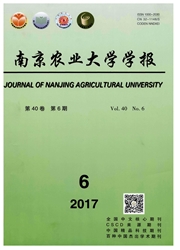

 中文摘要:
中文摘要:
夏季草坪斑枯病是由子囊菌纲巨座壳科真菌Magnaporthe poae在夏季高温高湿环境下引起的一种草坪病害。对来源不同的24个Magnaporthe及其近缘种属Gaeumannomyces菌株的ITS1-5.8S-ITS2测序序列进行比较及系统发育分析。结果表明:M.poae及其近缘种属真菌可分为A和B 2个群:A群由M.oryzae和Pyricularia oryzae菌种组成并形成2个分支,二者亲缘关系较近,且具有侵染寄主植物根部和地上部分的能力。B群由M.salvinii、M.poae、M.rhizophila、G.incrustans和G.graminis种内的2个变种(G.graminis var.graminis和G.graminis var.tritici)组成,B群真菌除M.salvinii外均有侵染寄主根部能力。在草坪环境中,B群真菌种内检测鉴定较A群困难。本研究根据真菌ITS基因的种内序列高度保守,种间差异明显的特点,分别设计了基因宏阵列单体(20~24 bp)、二聚体(40~48 bp)和单体加20个“A”(30~34 bp)3种寡核苷酸基因宏阵列检测探针来快速检测鉴定B群病原真菌。基因宏阵列检测结果表明:设计的检测探针均能准确、特异地检测鉴定B群的3种真菌,检测灵敏度从高到低依次为:二聚体探针、单体加20个“A”探针、单体探针。结论:在草坪土壤环境中,二聚体基因宏阵列检测探针(40~48 bp)对于Magnaporthe及其近缘种属菌株的检测较传统的单体检测探针更为灵敏与准确。
 英文摘要:
英文摘要:
Summer patch is a destructive disease of Kentucky bluegrass ( Poa prateasis) caused by Magnaporthe poae, which usually begins to emerge when the soil temperature and humidity are high. In this study,we sequenced 24 Magnaporthe and its related strains based on the ITS1-5.SS-ITS2 gene, and then investigated the ITS phylogennetic characterization. The results suggested that stains of M. poae and its related species distributed to two phylogennetic groups( A and B). M. oryzae and Pyricularia oryzae formed group A and was further divided into two clades, suggesting that M. oryzae is more closely related to P. oryzae, these species infect both root and aerial parts of the plant host. Group B contains M. salvinii ,M. poae ,M. rhizophila , Gaeumannomyces incrustans , G. graminis var. graminis and G. graminis var. tritici. These species of group B could infect root aparts of the plant host when excluding M. salvinii. In the turf en- vironment ,the detection of the species of group B is more difficult than that of group A if by morphological detection. Based on the mo- lecular characterization of ITS gene ,we produced a macroarray, which included three types of oligonucleotide probes:monomers (20-24 bp), dimers(40-48 bp), and monomers with a poly-A tail of 20 (30-44 bp)bases, respectively. The results showed that M. poae, G. incrustans and G. graminis of group B could be quickly detected and identified by the designed array. The detect sensitivities of dimers are significantly higher than the monomers-A20,still higher than monomers. The use of repeat sequence probes (dimers)greatly improved the sensitivity of the macroarray,which can be used in turf pathogen detection in the future.
 同期刊论文项目
同期刊论文项目
 同项目期刊论文
同项目期刊论文
 期刊信息
期刊信息
